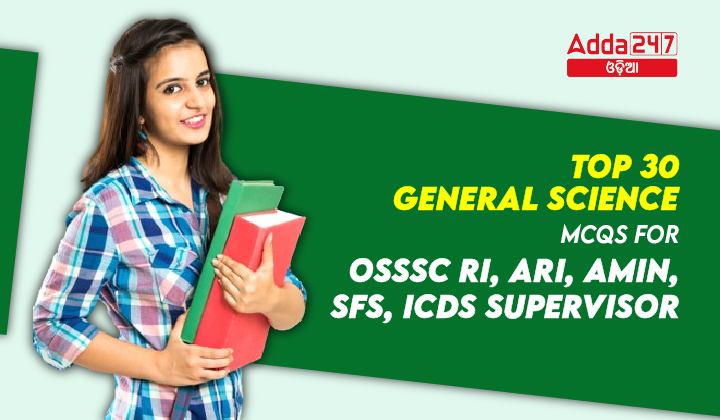OSSSC RI, ARI, Amin, SFS, ICDS Supervisor exams often include a section on general science to assess candidates’ knowledge of fundamental scientific principles. This article presents a curated list of 30 General Science Multiple Choice Questions (MCQs) suitable for individuals preparing for OSSSC RI, ARI, Amin, SFS, ICDS Supervisor exams. These questions are designed to challenge your understanding of current science .
Top 30 General Science MCQS For OSSSC RI,ARI, Amin, SFS, ICDS Supervisor
Mastering these general science concepts is crucial for success in competitive exams. Regular practice with such MCQs will not only enhance your knowledge but also improve your problem-solving skills. Remember to review the explanations for each answer to deepen your understanding of these fundamental scientific principles. Good luck with your preparations!
- What type of tissue is found beneath the skin, around the kidneys, and between the internal organs?
a) Ligament
b) Areolar
c) Tendons
d) Adipose
Answer: d) Adipose - Which of the following is the purest form of Carbon?
a) Charcoal
b) Granite
c) Diamond
d) Graphite
Answer: c) Diamond - Which of the following statements is true for metals?
a) Metals have 1 to 3 valence electrons in their outermost orbit
b) Metals have 1 to 4 valence electrons in their outermost shell
c) Metals have 8 valence electrons in their outermost shell
d) Metals have 4 or more valence electrons in their outermost orbit
Answer: a) Metals have 1 to 3 valence electrons in their outermost orbit - The kinetic energy acquired by a mass (m) in traveling distance starting from rest under the action of constant force is directly proportional to?
a) 1/m
b) m^0
c) m
d) 1/√m
Answer: b) m^0 - The work done in moving a charge from one point to the other is 20 J. If the potential difference between the points is 10 V, the charge is?
a) 4.0 C
b) 2.0 C
c) 0.5 C
d) 1.0 C
Answer: b) 2.0 C - Group of cells having a common origin and performing similar functions are called?
a) Tissues
b) Organs
c) Organ systems
d) None of the above
Answer: a) Tissues - A body of mass m moving with velocity 4 km/h collides with a body of mass 3 m at rest. Now the coalesced mass starts to move with a velocity of?
a) 4 km/h
b) 4/3 km/h
c) 1 km/h
d) 2 km/h
Answer: c) 1 km/h - Which organ of the body is affected by Leukoderma?
a) Heart
b) Kidney
c) Lungs
d) Skin
Answer: d) Skin - What is the third proportional to 9 and 12?
a) 19
b) 16
c) 18
d) 17
Answer: b) 16 - Which one of the following is an Enzyme?
a) Glucagon
b) Insulin
c) Somatotrophin
d) Trypsin
Answer: d) Trypsin - A 5 Ω resistance wire is doubled on it. Calculate the new resistance of the wire?
a) 1.25 Ω
b) 2.25 Ω
c) 1.5 Ω
d) 1.00 Ω
Answer: a) 1.25 Ω - On applying a constant force to a body, it moves with uniform?
a) Momentum
b) Speed
c) Velocity
d) Acceleration
Answer: d) Acceleration - ‘Gallon’ is commonly used?
a) To refer to a container
b) To refer to speed
c) As a measure of volume
d) To express containers in terms of a barrel
Answer: c) As a measure of volume - How is the sex of children determined?
a) Nature
b) Father
c) Mother
d) Mother and father
Answer: b) Father - When is the least weight shown on a spring balance with a stone tied to it?
a) When the stone is partially submerged in water in a beaker
b) When the stone is completely submerged in water in a beaker
c) When the stone is on the surface of water taken in a beaker
d) When the stone is suspended in air
Answer: b) When the stone is completely submerged in water in a beaker - Which equation represents the position-time relation?
a) 2as = v^2 – u^2
b) s = ut + 1/2at^2
c) v = u + at
d) V = u + at
Answer: b) s = ut + 1/2at^2 - What happens to the density if the mass of a solid is doubled?
a) Becomes two times
b) Becomes half
c) Remains unchanged
d) Becomes four times
Answer: a) Becomes two times - Why do fats and oils become rancid?
a) Transpiration
b) Reduction
c) Oxidation
d) Corrosion
Answer: c) Oxidation - What are the forces between two bodies?
a) Unequal and in the opposite direction
b) Equal and in the opposite direction
c) Equal and in the same direction
d) Isolated forces
Answer: b) Equal and in the opposite direction - What remains constant and what changes regarding mass and weight in different places?
a) The mass and weight of a body change from place to place
b) The mass of a body remains the same while the weight changes from place to place
c) The mass of a body changes from place to place while the weight remains the same
d) The mass and weight of the body remain the same in different places
Answer: b) The mass of a body remains the same while the weight changes from place to place - If u = 0 m/s, a = 5 m/s^2, and t = 5 s, then what is v?
a) 10 m/s
b) 25 m/s
c) 10 m/s
d) 35 m/s
Answer: b) 25 m/s - What is the SI unit of electric charge?
a) Wait
b) Ohm
c) Ampere
d) Coulomb
Answer: d) Coulomb - On applying a constant force to a body, it moves with uniform _____?
a) Momentum
b) Speed
c) Velocity
d) Acceleration
Answer: d) Acceleration - An electric bulb having voltage 240V and current 0.6 A has a power of _________?
a) 40W
b) 400W
c) 144W
d) 14.4W
Answer: c) 144W - Which of the following is the least reactive element belonging to group 17?
a) Bromine
b) Iodine
c) Chlorine
d) Fluorine
Answer: b) Iodine - The force of attraction between two objects is called the?
a) centripetal force
b) electromagnetic force
c) gravitational force
d) centrifugal force
Answer: c) gravitational force - An ultrasonic sound wave has a frequency higher than?
a) 20 Hz
b) 20000 Hz
c) 200 Hz
d) 2000 Hz
Answer: b) 20000 Hz - In the case of hypermetropia, where is the image formed?
a) In front of the retina
b) On the retina
c) Behind the retina
d) On the cornea
Answer: c) Behind the retina - In which of the following classifications are the elements arranged in the order of their increasing atomic number?
a) The Modern Periodic Table
b) Mendeleev’s Periodic Table
c) Newland’s Law of Octaves
d) Dobereiner’s Triads
Answer: a) The Modern Periodic Table - Which one of the following is NOT linked to the cerebrum?
a) It is a part of the forebrain
b) It has two parts called cerebral hemispheres
c) It forms the front, superior, and lateral side of the brain
d) It is the largest part constituting 60% of the brain
Answer: d) It is the largest part constituting 60% of the brain - The conversion of a solid directly into its vapour is called?
a) Evaporation
b) Condensation
c) Vaporisation
d) Sublimation
Answer: d) Sublimation - Which of the following produces Testosterone in man?
a) Prostate gland
b) Scrotum
c) Testes
d) Vas deferens
Answer: c) Testes - Which of the following produces Testosterone in man?
a) Prostate gland
b) Scrotum
c) Testes
d) Vas deferens
Answer: c) Testes










